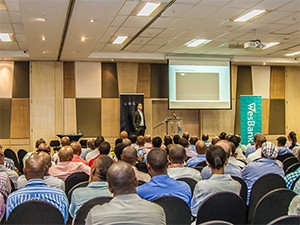
UberRUSH, an on-demand parcel delivery system, is one of the products Uber SA is looking to bring to South Africa by the end of 2016.
The product is in use in the US, and Uber SA GM Alon Lits says it would be a great fit for this country. UberRUSH works similarly to the current app, but instead of hailing a taxi for a person, users are able to hail a taxi for a parcel.
This was announced at an Uber driver-partner appreciation event last week, where 400 of the top Uber drivers in Gauteng were invited to listen to the company's plans for 2016, and voice concerns they may have with the platform.
Parcel delivery via Uber is already being done informally. When asked if drivers had ever been requested to transport goods instead of people, more than half the drivers in the room raised their hands.
UberRUSH is aimed at small businesses that want to cut down on courier costs or personal time on the road. The app allows users on both ends to track the delivery in real-time and only kilometres on the road are charged, as opposed to roundtrip delivery costs.
Lits did not give a launch date for UberRUSH in SA but said the firm hopes to formalise it within 2016.
Less downtime
UberRUSH is part of the company's plans to minimise drivers' wait time between passengers. Parcels are typically delivered during the day, when Uber does not get a lot of requests for passengers. This means drivers will be able to fill their time in between the morning and afternoon rush, by delivering goods and therefore earning more money.
Lits addressed one of the concerns about there being too many Uber cars on the road. "The more cars we have on the road, the more reliable Uber becomes and demand goes up."
He said the average wait time in and around Johannesburg is less than five minutes, which makes the app a dependable public transport system.
"More cars also means there are less 'dead' kilometres taking place, less kilometres driven without a passenger [or parcel] in the car."
There is, however, a waiting list for new drivers who want to join Uber. Lits said supply and demand is constantly assessed so that the market is not flooded. Preference is given to drivers turned Uber car-owners, as opposed to people who own fleets of cars already.
Lits said the company does not disclose exact numbers of drivers but, "across SA over 4 000 economic opportunities have been enabled since launching in August 2013".
Improvements to the platform, on the driver's side of the app, were also announced. Forward Dispatch is one of features that got the most cheers from drivers. It allows drivers to receive a request from another rider while they are still on another trip. Previously, trips would have to end before other requests could come through. This meant drivers would have to wait around after trips and not drive directly to where they were needed.
Five-star rating
Uber uses a rating system for both its drivers and passengers to control the quality of the experience. Experienced drivers need to keep an average rating of 4.4 out of five in Johannesburg to stay on the platform. An experienced driver is defined by having completed over 100 trips.
Lits says if drivers fall below this rating, their account is deactivated, but they are given the chance to get more training before joining again.
Passengers are also rated by drivers, and their accounts can be deactivated if they are consistently rated badly. Passengers will be e-mailed warnings before this happens. Warnings will be sent to riders who try to overload Uber cars, smoke in the car, and try to touch the steering wheel while driving, among other things.
Lits says deactivation is assessed case-by-case for drivers and passengers.
Slow-acting government
Last year, it was reported government regulation was stifling Uber growth in SA. The company now says it is finally coming to an understanding with the Department of Transport, which has admitted it is not as fast to act or as innovative as the taxi-hailing service and the process takes longer.
"The Department of Transport is thinking openly about how to help Uber drivers, and licences are being issued," says Lits.
Other concerns raised surrounded last year's driver intimidation attacks and the lack of woman drivers on the platform. Uber says attacks have subsided this year, but a toll-free hot line for drivers has been set up to make sure matters are escalated quickly.
Addressing the lack of woman drivers, Lits says Uber hopes to expand the current 4% of Gauteng woman drivers to 10% through various initiatives this year.
Uber launched in August 2013 in Johannesburg, the 34th city in the world to have the platform active. There are now over 400 cities using Uber in over 70 countries and over a million drivers globally. South Africa was also the first country outside of the US where three cities were operational at the same time.
The platform is growing rapidly in the country. In 2014, there were over one million trips in SA performed on the platform. In the first half of 2015, there were over two million trips booked.
Share